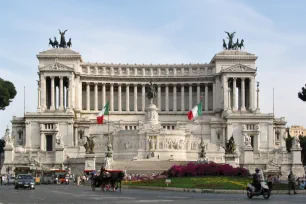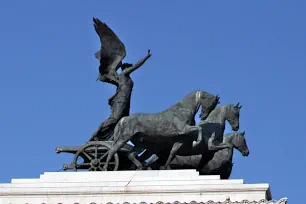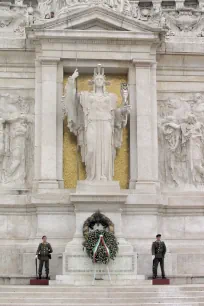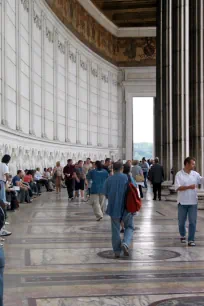Officially known as the Monumento Nazionale a Vittorio Emanuele II, the enormous white marble monument that dominates Piazza Venezia was built as a tribute to the first king of a united Italy, Victor Emmanuel II.


As King of Sardinia and victor over the Austrian army in Lombardy, Victor Emmanuel had become a symbol of the Risorgimento, the movement for a united Italy. After his army joined forces with Garibaldi and defeated the papal army, the Kingdom of Italy was proclaimed in 1861 with Victor Emmanuel as king.
Construction
In 1885 construction of the monument started after a design by Giuseppe Sacconi, winner of an architectural contest. The northern slope of the Capitoline Hill was cleared to make way for the monument. Roman ruins and medieval churches were destroyed in the process. Sacconi never saw his monument completed; he died in 1905 and was succeeded by three architects: Manfredo Manfredi, Pio Piacentini and Gaetano Koch. The new monument and national symbol of Italy was inaugurated in 1911, at the fiftieth anniversary of the kingdom.
The Monument



The Monument to Victor Emanuel II, also known as ‘Il Vittoriano’ and sometimes also referred to as the Altare della Patria (Altar of the Nation), is a bombastic monument built with sparkling white marble from Botticino in the province of Brescia. It is decorated with numerous allegorical statues, reliefs and murals, created by artists from all corners of the country.
The monument, about 80 meters high and 120 meters wide (260 x 390 ft.), consists of a large flight of stairs leading up to a massive colonnade. To the right and left of the main entrance – which is closed off by a gate at night – are two fountains, allegorical representations of the two seas that border Italy. The left one depicts the Adriatic Sea and the right one is the Tyrrhenian Sea.
At the center of the monument is the colossal equestrian statue of Victor Emmanuel, the ‘Father of the Nation’. The statue, the work of sculptor Enrico Chiaradia, weighs fifty tons and measures twelve meters long (39 feet). It rests on a pedestal decorated with allegorical reliefs representing Italian cities.
At the foot of the statue is the Tomb of the Unknown Soldier, inaugurated in 1921. Guards of honor, alternatingly selected from the marine, infantry and air divisions, stand on guard here day and night.
The upper section of the monument consists of a massive curved colonnade with fifteen-meter-tall (50 ft) columns, framed on either side by small temple-like wings with a classical front. The design of the colonnade was likely inspired by the double colonnade of the Domus Augustae that overlooked the Circus Maximus in the Antiquity. Inside, the colonnade is decorated with murals and the frieze on top is adorned with statues that symbolize the regions of Italy.
Two bronze quadrigae crown the monument, each with a statue of a winged Victory. The quadriga on the right represents freedom, while the one on the left represents unity. They were added in 1927, sixteen years after the monument was inaugurated.
Museum of the Risorgimento

Inside the monument are large rooms; half of those are used for exhibitions. The other half houses the Museo Centrale del Risorgimento, a museum dedicated to the history of the unification of Italy. The museum’s entrance is to the left of the monument, at the Via di San Pietro in Carcere. The museum charts the events that led to the unification with a display of paintings, documents, statues, photographs and memorabilia such as coins and flags.
Views

The Victor Emmanuel Monument is not exactly known as one of Rome’s most beautiful structures. It is considered too monumental, and the bright white color does not fit well into the ocher color of its surroundings. The monument has been given nicknames such as ‘typewriter’ and ‘wedding cake’.
The monument is nevertheless well worth the visit, even if only for the great views from the top. The top of the monument is also connected to the Capitoline Square, saving you another climb of the Capitoline Hill.
- Next: Trajan's Column
- More Sights & Attractions in Rome

